Enterprise Leadership: Impact on Business Performance and Culture
VerifiedAdded on 2022/09/07
|8
|1902
|17
Essay
AI Summary
This essay delves into the concept of enterprise leadership, defining it as a strategic approach where leaders prioritize the firm's best interests through their executive and thinking styles, focusing on efficient corporate behavior. It examines how effective enterprise leadership can significantly enhance business performance, emphasizing the influence of leadership dimensions on organizational culture. The essay explores various leadership styles, including transformational and transactional approaches, highlighting their impact on enterprise performance, culture, and communication. It also discusses team leadership behavior and its importance in dynamic business settings, along with the role of organizational culture. Furthermore, the essay addresses the challenges faced by global leaders and the need for a global leadership approach. The conclusion emphasizes the significance of effective leadership styles and behaviors in fostering a positive corporate culture and building strong teams to achieve enhanced organizational performance.
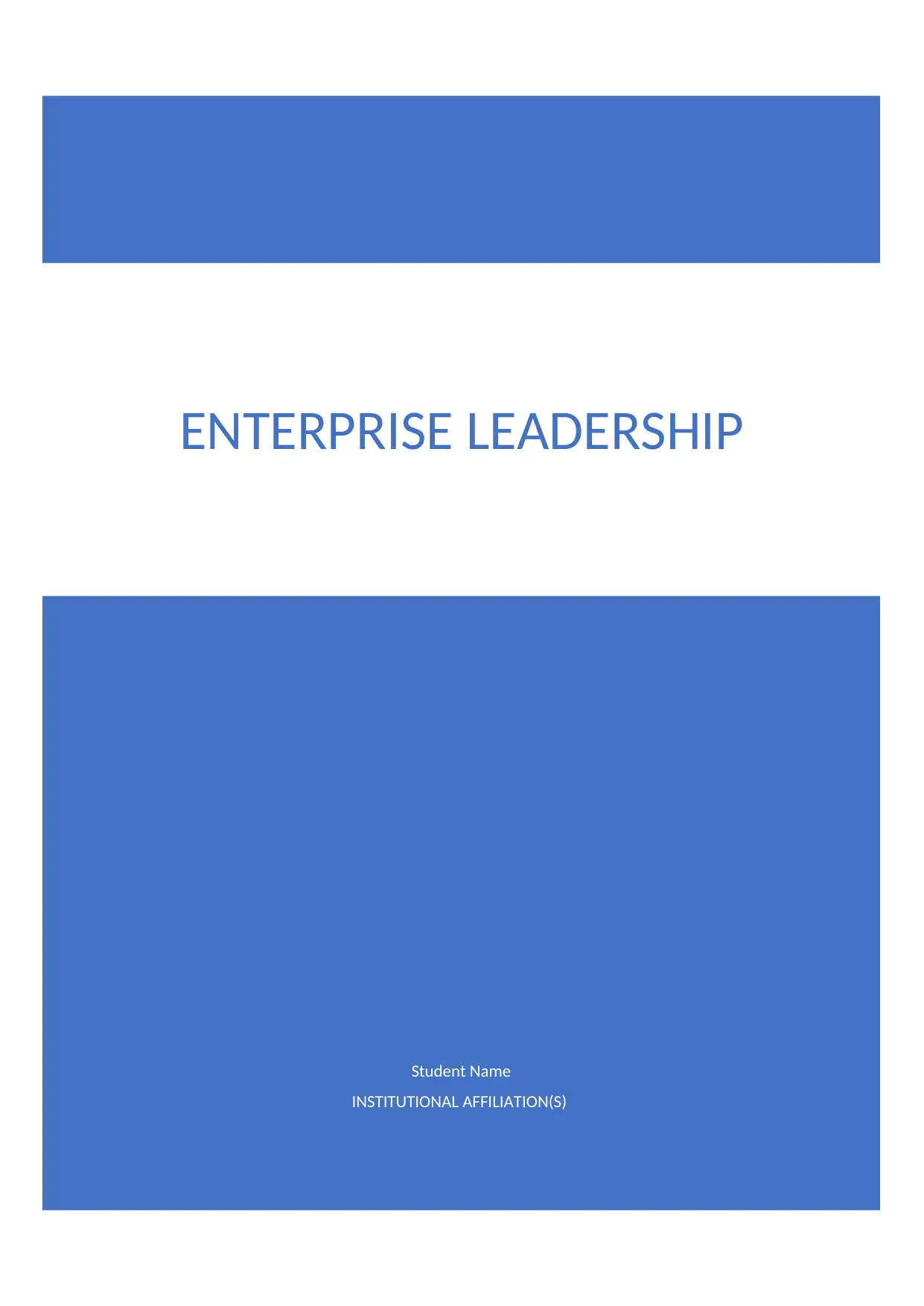
Student Name
INSTITUTIONAL AFFILIATION(S)
ENTERPRISE LEADERSHIP
INSTITUTIONAL AFFILIATION(S)
ENTERPRISE LEADERSHIP
Paraphrase This Document
Need a fresh take? Get an instant paraphrase of this document with our AI Paraphraser
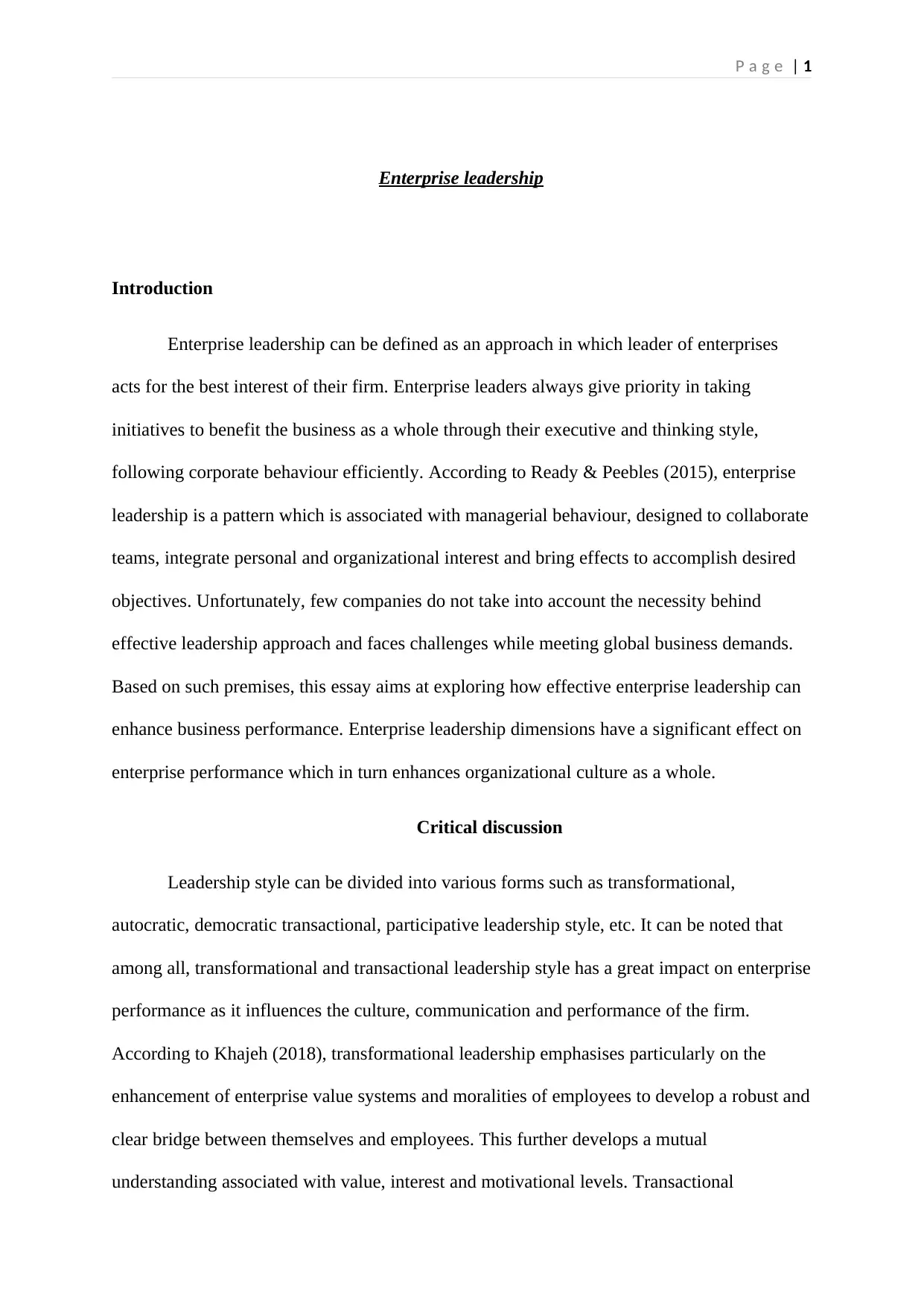
P a g e | 1
Enterprise leadership
Introduction
Enterprise leadership can be defined as an approach in which leader of enterprises
acts for the best interest of their firm. Enterprise leaders always give priority in taking
initiatives to benefit the business as a whole through their executive and thinking style,
following corporate behaviour efficiently. According to Ready & Peebles (2015), enterprise
leadership is a pattern which is associated with managerial behaviour, designed to collaborate
teams, integrate personal and organizational interest and bring effects to accomplish desired
objectives. Unfortunately, few companies do not take into account the necessity behind
effective leadership approach and faces challenges while meeting global business demands.
Based on such premises, this essay aims at exploring how effective enterprise leadership can
enhance business performance. Enterprise leadership dimensions have a significant effect on
enterprise performance which in turn enhances organizational culture as a whole.
Critical discussion
Leadership style can be divided into various forms such as transformational,
autocratic, democratic transactional, participative leadership style, etc. It can be noted that
among all, transformational and transactional leadership style has a great impact on enterprise
performance as it influences the culture, communication and performance of the firm.
According to Khajeh (2018), transformational leadership emphasises particularly on the
enhancement of enterprise value systems and moralities of employees to develop a robust and
clear bridge between themselves and employees. This further develops a mutual
understanding associated with value, interest and motivational levels. Transactional
Enterprise leadership
Introduction
Enterprise leadership can be defined as an approach in which leader of enterprises
acts for the best interest of their firm. Enterprise leaders always give priority in taking
initiatives to benefit the business as a whole through their executive and thinking style,
following corporate behaviour efficiently. According to Ready & Peebles (2015), enterprise
leadership is a pattern which is associated with managerial behaviour, designed to collaborate
teams, integrate personal and organizational interest and bring effects to accomplish desired
objectives. Unfortunately, few companies do not take into account the necessity behind
effective leadership approach and faces challenges while meeting global business demands.
Based on such premises, this essay aims at exploring how effective enterprise leadership can
enhance business performance. Enterprise leadership dimensions have a significant effect on
enterprise performance which in turn enhances organizational culture as a whole.
Critical discussion
Leadership style can be divided into various forms such as transformational,
autocratic, democratic transactional, participative leadership style, etc. It can be noted that
among all, transformational and transactional leadership style has a great impact on enterprise
performance as it influences the culture, communication and performance of the firm.
According to Khajeh (2018), transformational leadership emphasises particularly on the
enhancement of enterprise value systems and moralities of employees to develop a robust and
clear bridge between themselves and employees. This further develops a mutual
understanding associated with value, interest and motivational levels. Transactional
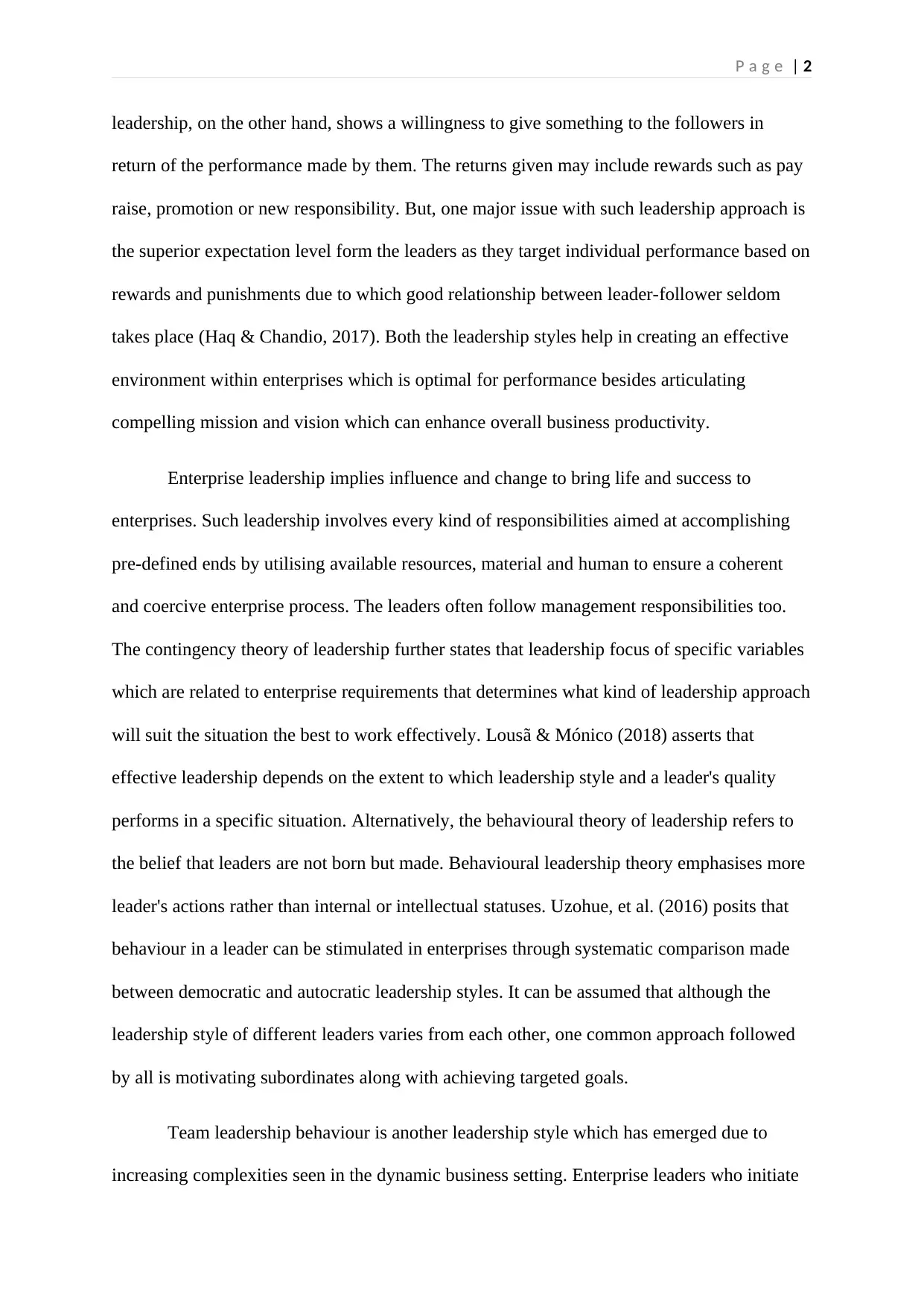
P a g e | 2
leadership, on the other hand, shows a willingness to give something to the followers in
return of the performance made by them. The returns given may include rewards such as pay
raise, promotion or new responsibility. But, one major issue with such leadership approach is
the superior expectation level form the leaders as they target individual performance based on
rewards and punishments due to which good relationship between leader-follower seldom
takes place (Haq & Chandio, 2017). Both the leadership styles help in creating an effective
environment within enterprises which is optimal for performance besides articulating
compelling mission and vision which can enhance overall business productivity.
Enterprise leadership implies influence and change to bring life and success to
enterprises. Such leadership involves every kind of responsibilities aimed at accomplishing
pre-defined ends by utilising available resources, material and human to ensure a coherent
and coercive enterprise process. The leaders often follow management responsibilities too.
The contingency theory of leadership further states that leadership focus of specific variables
which are related to enterprise requirements that determines what kind of leadership approach
will suit the situation the best to work effectively. Lousã & Mónico (2018) asserts that
effective leadership depends on the extent to which leadership style and a leader's quality
performs in a specific situation. Alternatively, the behavioural theory of leadership refers to
the belief that leaders are not born but made. Behavioural leadership theory emphasises more
leader's actions rather than internal or intellectual statuses. Uzohue, et al. (2016) posits that
behaviour in a leader can be stimulated in enterprises through systematic comparison made
between democratic and autocratic leadership styles. It can be assumed that although the
leadership style of different leaders varies from each other, one common approach followed
by all is motivating subordinates along with achieving targeted goals.
Team leadership behaviour is another leadership style which has emerged due to
increasing complexities seen in the dynamic business setting. Enterprise leaders who initiate
leadership, on the other hand, shows a willingness to give something to the followers in
return of the performance made by them. The returns given may include rewards such as pay
raise, promotion or new responsibility. But, one major issue with such leadership approach is
the superior expectation level form the leaders as they target individual performance based on
rewards and punishments due to which good relationship between leader-follower seldom
takes place (Haq & Chandio, 2017). Both the leadership styles help in creating an effective
environment within enterprises which is optimal for performance besides articulating
compelling mission and vision which can enhance overall business productivity.
Enterprise leadership implies influence and change to bring life and success to
enterprises. Such leadership involves every kind of responsibilities aimed at accomplishing
pre-defined ends by utilising available resources, material and human to ensure a coherent
and coercive enterprise process. The leaders often follow management responsibilities too.
The contingency theory of leadership further states that leadership focus of specific variables
which are related to enterprise requirements that determines what kind of leadership approach
will suit the situation the best to work effectively. Lousã & Mónico (2018) asserts that
effective leadership depends on the extent to which leadership style and a leader's quality
performs in a specific situation. Alternatively, the behavioural theory of leadership refers to
the belief that leaders are not born but made. Behavioural leadership theory emphasises more
leader's actions rather than internal or intellectual statuses. Uzohue, et al. (2016) posits that
behaviour in a leader can be stimulated in enterprises through systematic comparison made
between democratic and autocratic leadership styles. It can be assumed that although the
leadership style of different leaders varies from each other, one common approach followed
by all is motivating subordinates along with achieving targeted goals.
Team leadership behaviour is another leadership style which has emerged due to
increasing complexities seen in the dynamic business setting. Enterprise leaders who initiate
⊘ This is a preview!⊘
Do you want full access?
Subscribe today to unlock all pages.

Trusted by 1+ million students worldwide
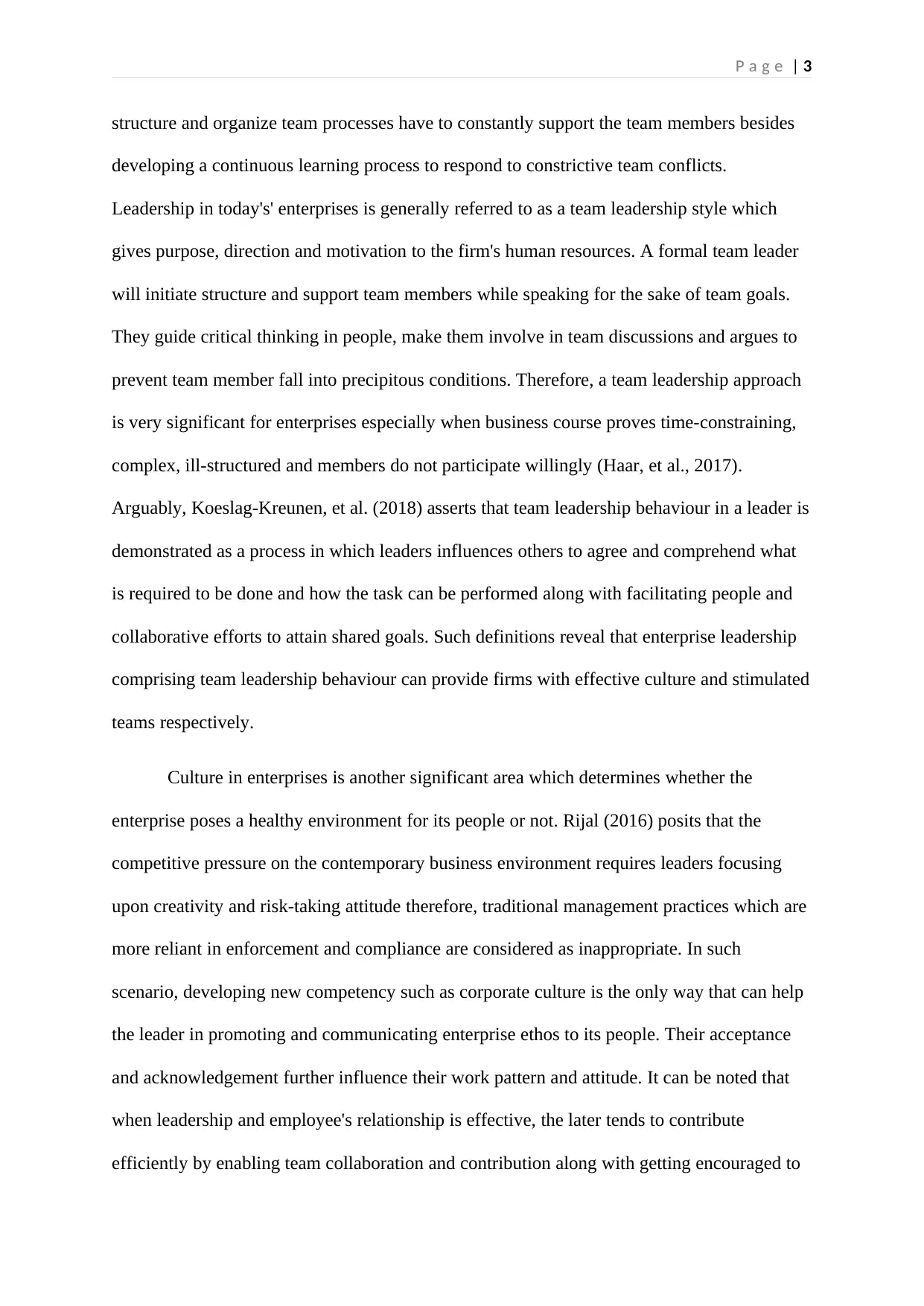
P a g e | 3
structure and organize team processes have to constantly support the team members besides
developing a continuous learning process to respond to constrictive team conflicts.
Leadership in today's' enterprises is generally referred to as a team leadership style which
gives purpose, direction and motivation to the firm's human resources. A formal team leader
will initiate structure and support team members while speaking for the sake of team goals.
They guide critical thinking in people, make them involve in team discussions and argues to
prevent team member fall into precipitous conditions. Therefore, a team leadership approach
is very significant for enterprises especially when business course proves time-constraining,
complex, ill-structured and members do not participate willingly (Haar, et al., 2017).
Arguably, Koeslag-Kreunen, et al. (2018) asserts that team leadership behaviour in a leader is
demonstrated as a process in which leaders influences others to agree and comprehend what
is required to be done and how the task can be performed along with facilitating people and
collaborative efforts to attain shared goals. Such definitions reveal that enterprise leadership
comprising team leadership behaviour can provide firms with effective culture and stimulated
teams respectively.
Culture in enterprises is another significant area which determines whether the
enterprise poses a healthy environment for its people or not. Rijal (2016) posits that the
competitive pressure on the contemporary business environment requires leaders focusing
upon creativity and risk-taking attitude therefore, traditional management practices which are
more reliant in enforcement and compliance are considered as inappropriate. In such
scenario, developing new competency such as corporate culture is the only way that can help
the leader in promoting and communicating enterprise ethos to its people. Their acceptance
and acknowledgement further influence their work pattern and attitude. It can be noted that
when leadership and employee's relationship is effective, the later tends to contribute
efficiently by enabling team collaboration and contribution along with getting encouraged to
structure and organize team processes have to constantly support the team members besides
developing a continuous learning process to respond to constrictive team conflicts.
Leadership in today's' enterprises is generally referred to as a team leadership style which
gives purpose, direction and motivation to the firm's human resources. A formal team leader
will initiate structure and support team members while speaking for the sake of team goals.
They guide critical thinking in people, make them involve in team discussions and argues to
prevent team member fall into precipitous conditions. Therefore, a team leadership approach
is very significant for enterprises especially when business course proves time-constraining,
complex, ill-structured and members do not participate willingly (Haar, et al., 2017).
Arguably, Koeslag-Kreunen, et al. (2018) asserts that team leadership behaviour in a leader is
demonstrated as a process in which leaders influences others to agree and comprehend what
is required to be done and how the task can be performed along with facilitating people and
collaborative efforts to attain shared goals. Such definitions reveal that enterprise leadership
comprising team leadership behaviour can provide firms with effective culture and stimulated
teams respectively.
Culture in enterprises is another significant area which determines whether the
enterprise poses a healthy environment for its people or not. Rijal (2016) posits that the
competitive pressure on the contemporary business environment requires leaders focusing
upon creativity and risk-taking attitude therefore, traditional management practices which are
more reliant in enforcement and compliance are considered as inappropriate. In such
scenario, developing new competency such as corporate culture is the only way that can help
the leader in promoting and communicating enterprise ethos to its people. Their acceptance
and acknowledgement further influence their work pattern and attitude. It can be noted that
when leadership and employee's relationship is effective, the later tends to contribute
efficiently by enabling team collaboration and contribution along with getting encouraged to
Paraphrase This Document
Need a fresh take? Get an instant paraphrase of this document with our AI Paraphraser
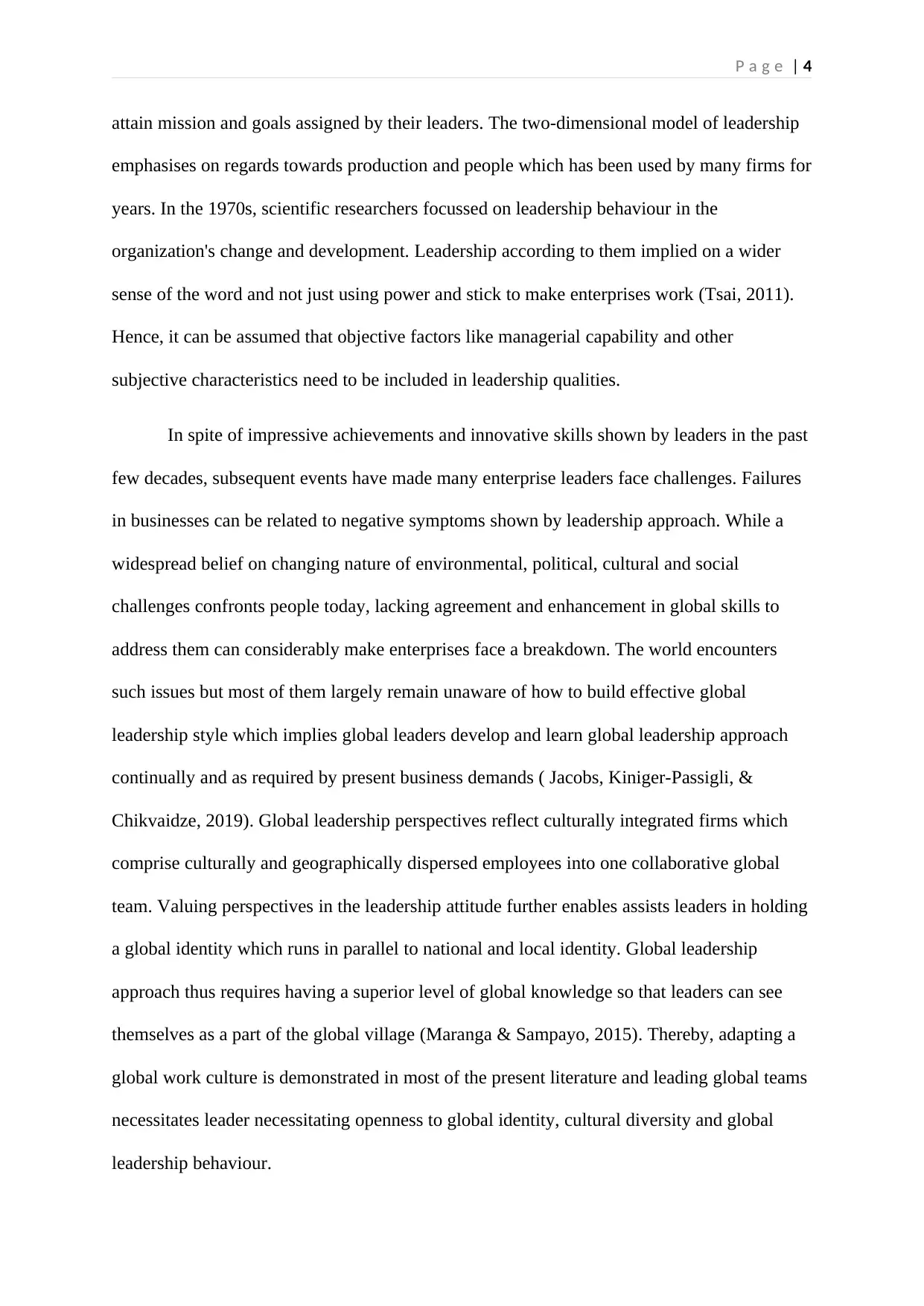
P a g e | 4
attain mission and goals assigned by their leaders. The two-dimensional model of leadership
emphasises on regards towards production and people which has been used by many firms for
years. In the 1970s, scientific researchers focussed on leadership behaviour in the
organization's change and development. Leadership according to them implied on a wider
sense of the word and not just using power and stick to make enterprises work (Tsai, 2011).
Hence, it can be assumed that objective factors like managerial capability and other
subjective characteristics need to be included in leadership qualities.
In spite of impressive achievements and innovative skills shown by leaders in the past
few decades, subsequent events have made many enterprise leaders face challenges. Failures
in businesses can be related to negative symptoms shown by leadership approach. While a
widespread belief on changing nature of environmental, political, cultural and social
challenges confronts people today, lacking agreement and enhancement in global skills to
address them can considerably make enterprises face a breakdown. The world encounters
such issues but most of them largely remain unaware of how to build effective global
leadership style which implies global leaders develop and learn global leadership approach
continually and as required by present business demands ( Jacobs, Kiniger-Passigli, &
Chikvaidze, 2019). Global leadership perspectives reflect culturally integrated firms which
comprise culturally and geographically dispersed employees into one collaborative global
team. Valuing perspectives in the leadership attitude further enables assists leaders in holding
a global identity which runs in parallel to national and local identity. Global leadership
approach thus requires having a superior level of global knowledge so that leaders can see
themselves as a part of the global village (Maranga & Sampayo, 2015). Thereby, adapting a
global work culture is demonstrated in most of the present literature and leading global teams
necessitates leader necessitating openness to global identity, cultural diversity and global
leadership behaviour.
attain mission and goals assigned by their leaders. The two-dimensional model of leadership
emphasises on regards towards production and people which has been used by many firms for
years. In the 1970s, scientific researchers focussed on leadership behaviour in the
organization's change and development. Leadership according to them implied on a wider
sense of the word and not just using power and stick to make enterprises work (Tsai, 2011).
Hence, it can be assumed that objective factors like managerial capability and other
subjective characteristics need to be included in leadership qualities.
In spite of impressive achievements and innovative skills shown by leaders in the past
few decades, subsequent events have made many enterprise leaders face challenges. Failures
in businesses can be related to negative symptoms shown by leadership approach. While a
widespread belief on changing nature of environmental, political, cultural and social
challenges confronts people today, lacking agreement and enhancement in global skills to
address them can considerably make enterprises face a breakdown. The world encounters
such issues but most of them largely remain unaware of how to build effective global
leadership style which implies global leaders develop and learn global leadership approach
continually and as required by present business demands ( Jacobs, Kiniger-Passigli, &
Chikvaidze, 2019). Global leadership perspectives reflect culturally integrated firms which
comprise culturally and geographically dispersed employees into one collaborative global
team. Valuing perspectives in the leadership attitude further enables assists leaders in holding
a global identity which runs in parallel to national and local identity. Global leadership
approach thus requires having a superior level of global knowledge so that leaders can see
themselves as a part of the global village (Maranga & Sampayo, 2015). Thereby, adapting a
global work culture is demonstrated in most of the present literature and leading global teams
necessitates leader necessitating openness to global identity, cultural diversity and global
leadership behaviour.
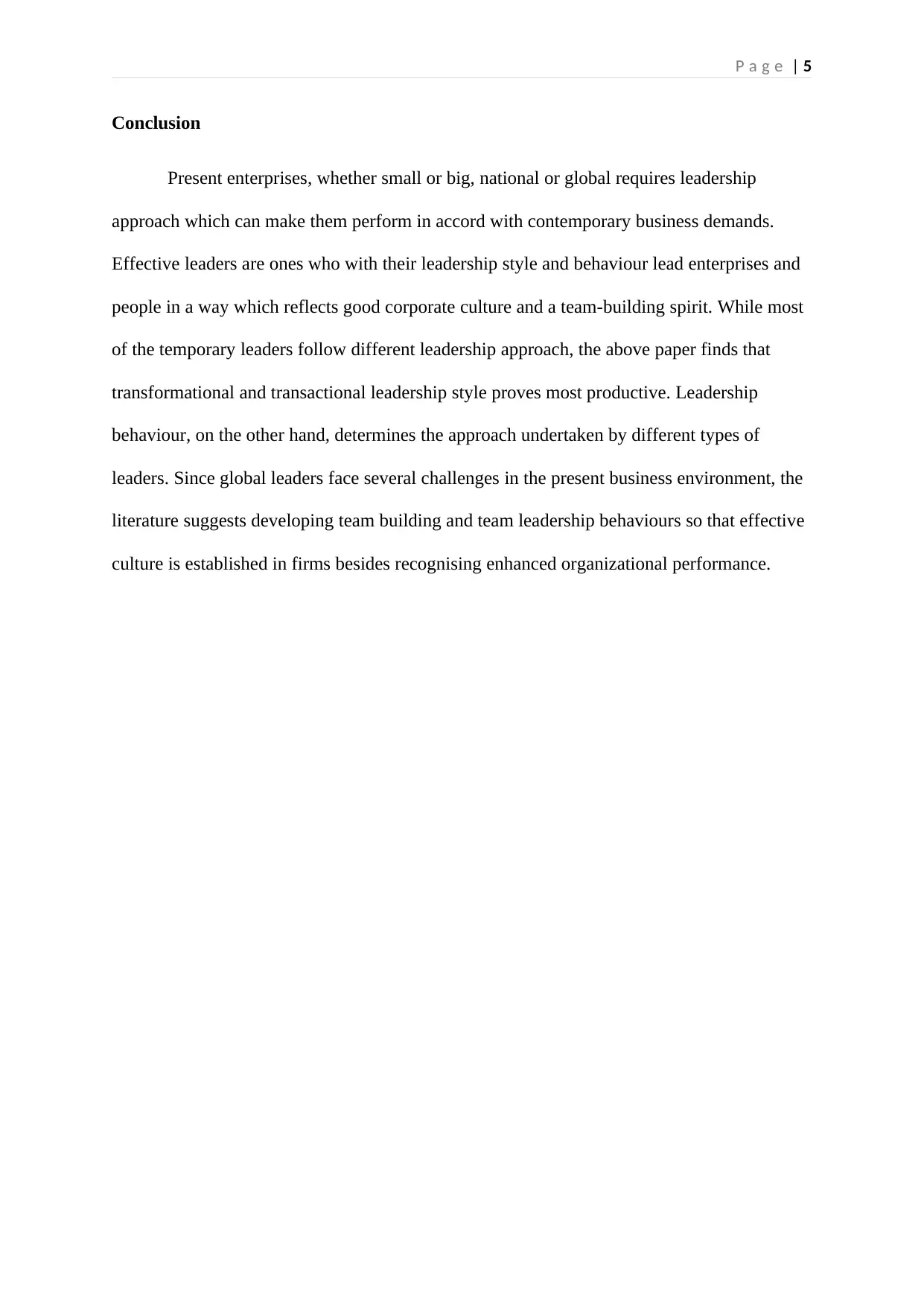
P a g e | 5
Conclusion
Present enterprises, whether small or big, national or global requires leadership
approach which can make them perform in accord with contemporary business demands.
Effective leaders are ones who with their leadership style and behaviour lead enterprises and
people in a way which reflects good corporate culture and a team-building spirit. While most
of the temporary leaders follow different leadership approach, the above paper finds that
transformational and transactional leadership style proves most productive. Leadership
behaviour, on the other hand, determines the approach undertaken by different types of
leaders. Since global leaders face several challenges in the present business environment, the
literature suggests developing team building and team leadership behaviours so that effective
culture is established in firms besides recognising enhanced organizational performance.
Conclusion
Present enterprises, whether small or big, national or global requires leadership
approach which can make them perform in accord with contemporary business demands.
Effective leaders are ones who with their leadership style and behaviour lead enterprises and
people in a way which reflects good corporate culture and a team-building spirit. While most
of the temporary leaders follow different leadership approach, the above paper finds that
transformational and transactional leadership style proves most productive. Leadership
behaviour, on the other hand, determines the approach undertaken by different types of
leaders. Since global leaders face several challenges in the present business environment, the
literature suggests developing team building and team leadership behaviours so that effective
culture is established in firms besides recognising enhanced organizational performance.
⊘ This is a preview!⊘
Do you want full access?
Subscribe today to unlock all pages.

Trusted by 1+ million students worldwide
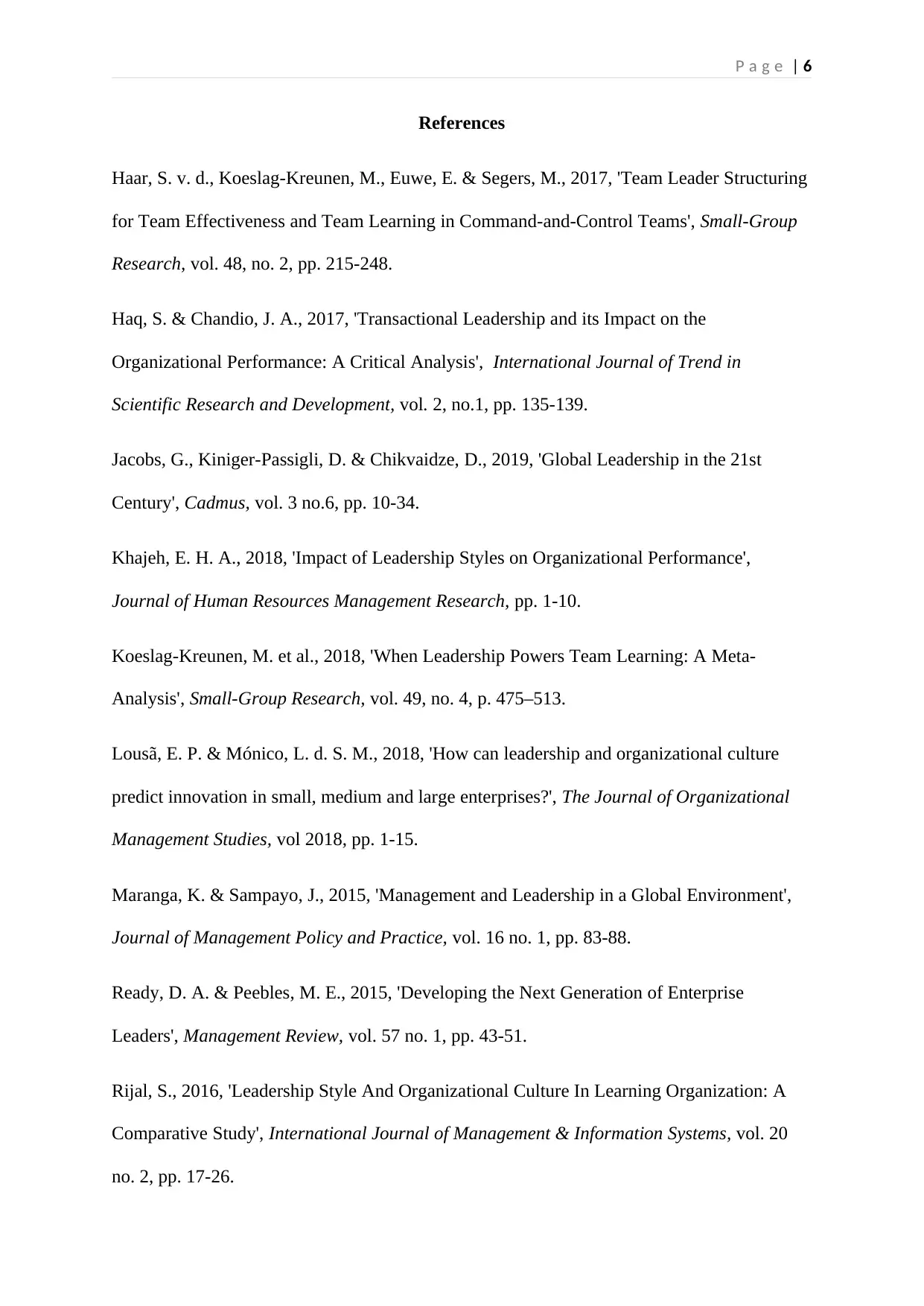
P a g e | 6
References
Haar, S. v. d., Koeslag-Kreunen, M., Euwe, E. & Segers, M., 2017, 'Team Leader Structuring
for Team Effectiveness and Team Learning in Command-and-Control Teams', Small-Group
Research, vol. 48, no. 2, pp. 215-248.
Haq, S. & Chandio, J. A., 2017, 'Transactional Leadership and its Impact on the
Organizational Performance: A Critical Analysis', International Journal of Trend in
Scientific Research and Development, vol. 2, no.1, pp. 135-139.
Jacobs, G., Kiniger-Passigli, D. & Chikvaidze, D., 2019, 'Global Leadership in the 21st
Century', Cadmus, vol. 3 no.6, pp. 10-34.
Khajeh, E. H. A., 2018, 'Impact of Leadership Styles on Organizational Performance',
Journal of Human Resources Management Research, pp. 1-10.
Koeslag-Kreunen, M. et al., 2018, 'When Leadership Powers Team Learning: A Meta-
Analysis', Small-Group Research, vol. 49, no. 4, p. 475–513.
Lousã, E. P. & Mónico, L. d. S. M., 2018, 'How can leadership and organizational culture
predict innovation in small, medium and large enterprises?', The Journal of Organizational
Management Studies, vol 2018, pp. 1-15.
Maranga, K. & Sampayo, J., 2015, 'Management and Leadership in a Global Environment',
Journal of Management Policy and Practice, vol. 16 no. 1, pp. 83-88.
Ready, D. A. & Peebles, M. E., 2015, 'Developing the Next Generation of Enterprise
Leaders', Management Review, vol. 57 no. 1, pp. 43-51.
Rijal, S., 2016, 'Leadership Style And Organizational Culture In Learning Organization: A
Comparative Study', International Journal of Management & Information Systems, vol. 20
no. 2, pp. 17-26.
References
Haar, S. v. d., Koeslag-Kreunen, M., Euwe, E. & Segers, M., 2017, 'Team Leader Structuring
for Team Effectiveness and Team Learning in Command-and-Control Teams', Small-Group
Research, vol. 48, no. 2, pp. 215-248.
Haq, S. & Chandio, J. A., 2017, 'Transactional Leadership and its Impact on the
Organizational Performance: A Critical Analysis', International Journal of Trend in
Scientific Research and Development, vol. 2, no.1, pp. 135-139.
Jacobs, G., Kiniger-Passigli, D. & Chikvaidze, D., 2019, 'Global Leadership in the 21st
Century', Cadmus, vol. 3 no.6, pp. 10-34.
Khajeh, E. H. A., 2018, 'Impact of Leadership Styles on Organizational Performance',
Journal of Human Resources Management Research, pp. 1-10.
Koeslag-Kreunen, M. et al., 2018, 'When Leadership Powers Team Learning: A Meta-
Analysis', Small-Group Research, vol. 49, no. 4, p. 475–513.
Lousã, E. P. & Mónico, L. d. S. M., 2018, 'How can leadership and organizational culture
predict innovation in small, medium and large enterprises?', The Journal of Organizational
Management Studies, vol 2018, pp. 1-15.
Maranga, K. & Sampayo, J., 2015, 'Management and Leadership in a Global Environment',
Journal of Management Policy and Practice, vol. 16 no. 1, pp. 83-88.
Ready, D. A. & Peebles, M. E., 2015, 'Developing the Next Generation of Enterprise
Leaders', Management Review, vol. 57 no. 1, pp. 43-51.
Rijal, S., 2016, 'Leadership Style And Organizational Culture In Learning Organization: A
Comparative Study', International Journal of Management & Information Systems, vol. 20
no. 2, pp. 17-26.
Paraphrase This Document
Need a fresh take? Get an instant paraphrase of this document with our AI Paraphraser
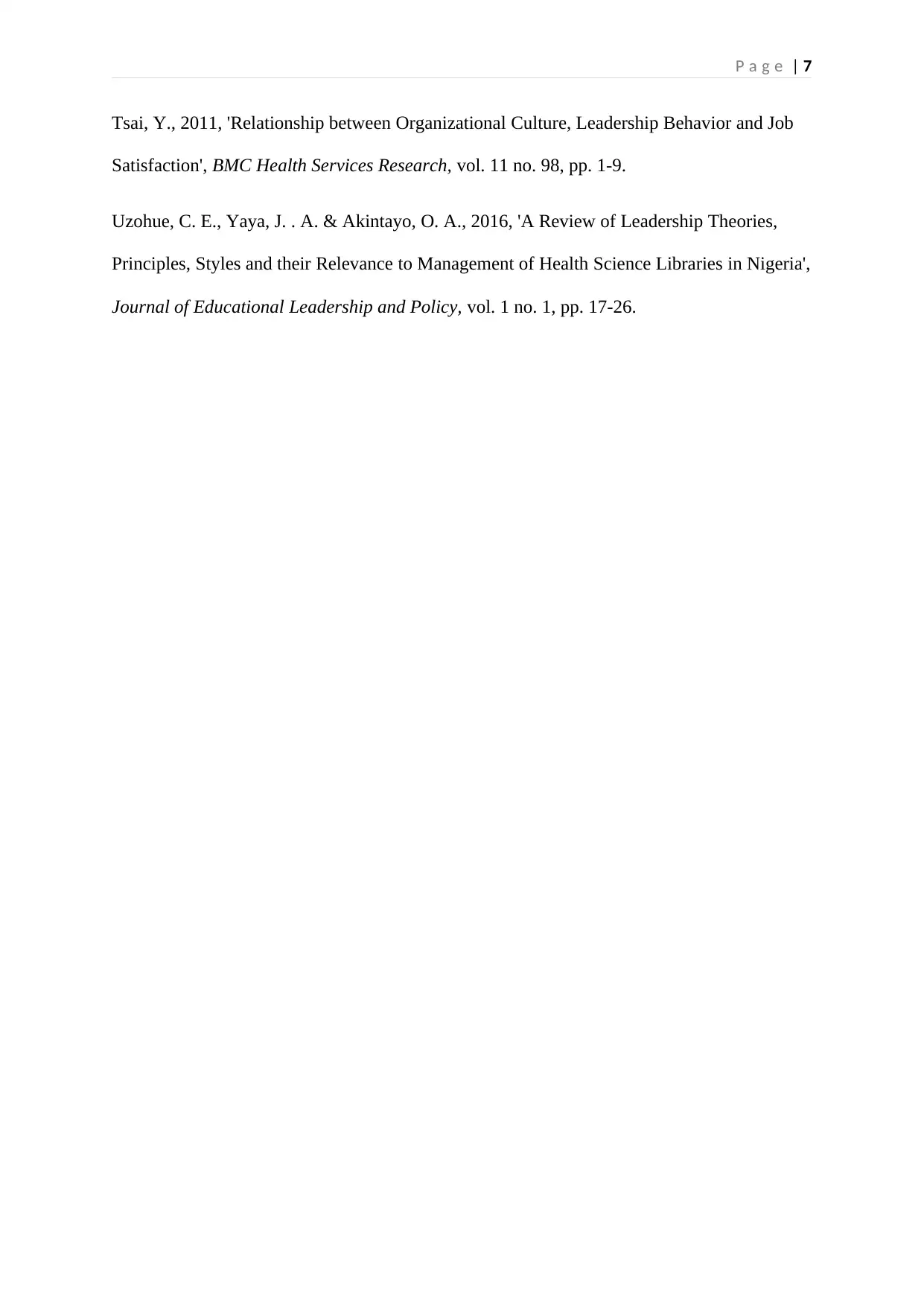
P a g e | 7
Tsai, Y., 2011, 'Relationship between Organizational Culture, Leadership Behavior and Job
Satisfaction', BMC Health Services Research, vol. 11 no. 98, pp. 1-9.
Uzohue, C. E., Yaya, J. . A. & Akintayo, O. A., 2016, 'A Review of Leadership Theories,
Principles, Styles and their Relevance to Management of Health Science Libraries in Nigeria',
Journal of Educational Leadership and Policy, vol. 1 no. 1, pp. 17-26.
Tsai, Y., 2011, 'Relationship between Organizational Culture, Leadership Behavior and Job
Satisfaction', BMC Health Services Research, vol. 11 no. 98, pp. 1-9.
Uzohue, C. E., Yaya, J. . A. & Akintayo, O. A., 2016, 'A Review of Leadership Theories,
Principles, Styles and their Relevance to Management of Health Science Libraries in Nigeria',
Journal of Educational Leadership and Policy, vol. 1 no. 1, pp. 17-26.
1 out of 8
Related Documents
Your All-in-One AI-Powered Toolkit for Academic Success.
+13062052269
info@desklib.com
Available 24*7 on WhatsApp / Email
![[object Object]](/_next/static/media/star-bottom.7253800d.svg)
Unlock your academic potential
Copyright © 2020–2025 A2Z Services. All Rights Reserved. Developed and managed by ZUCOL.





